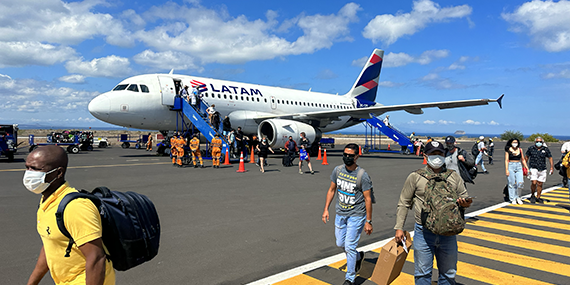VISITING THE GALAPAGOS - Plan your trip
The essentials regarding entry into Ecuador and the islands…

Almost all visitors to Ecuador can obtain a visa on arrival, provided their passport is valid for 6 months or more and they hold a return ticket. However, we always recommend that you double-check regarding up to the minute entry requirements with your local Ecuadorian Consulate.
Entry into the Galapagos islands is straightforward, but please be aware of the following:
1 - All flights to Galapagos originate on mainland Ecuador, there are no direct international connections.
2 - Due to flight times, it is usual for visitors to overnight on the mainland upon arrival, flying out to Baltra airport or San Cristobal airport the following day.
3 - Tourists are usually limited to a maximum of 60 days residency per year. Please also bear in mind that visitors are required to undertake three key steps to enter the islands:
i) Obtain and pay for a Transit Control Immigration Card for each person in your group, at either Quito or Guayaquil airport.
The Governing Council of Galapagos uses the Transit Control Card System to monitor visitors´ time spent in the islands. The information you provide to obtain your TCC will be stored in a database that is accessible by the Governing Council’s Technical Secretary and institutional members, such as the Ecuadorian Ministries of Environment and Tourism. (The Governing Council classifies the information collected as confidential and does not make it available to 3rd parties).
You can go to the Ecuadorian Government’s special website page to complete your TCC before you arrive in country, or you can register in Ecuador just before you check in for your flight to the Galapagos form Quito or Guayaquil airport. Whichever method you choose, the TCC costs $20 per person.
ii) Go through Bio-security Bag Screening
After you have collected your TCC and before you check in at the airline counter, you will need to pass all your luggage through the Galapagos bio security screening x-ray machine. There is a limited list of fresh fruits and vegetables, nuts, and grains, that you can carry into the Galapagos. Generally, anything purchased in a store that is still sealed and with a label is okay but be aware you might have organic goods confiscated.
After you have your TCC documentation, have paid the fee for this, and have taken your bags through Bio security, you can check in (with your return tickets) at the counter of the airline with which you are flying.
iii) Pay your National Park Entrance Fee - in cash in USA dollars
Upon arrival in the islands, you will need to sign a declaration stating you are not traveling with anything that contravenes the bio-security regulations and pay the National Park entrance fee. There is an ATM in the airport, but please note that this does not always work.
The National Park entrance fee varies according to the visitor, see below:
Foreign tourists (not Ecuadorian resident) and over 12 years of age: $100
Foreign tourists, (not Ecuadorian resident) and under 12 years of age: $50
Foreign tourists, (not Ecuadorian resident) and over 12 years of age, who belong to the Andean Community of Nations (CAN)* or MERCOSUR**: $50
Foreign tourists, (not Ecuadorian resident) and under 12 years of age, who belon to the Andean Community of Nations (CAN)* or MERCOSUR**: $25
National or foreign tourists residing in Ecuador, over 12 years of age: $6
National or foreign tourists residing in Ecuador, under 12 years of age: $3
* CAN countries: Bolivia, Colombia, Peru.
** MERCOSUR countries: Argentina, Brazil, Paraguay, Uruguay, Venezuela.
Please remember that you will need to present the paperwork you are issued with during entry upon departure from your chosen airport in Galapagos, so don’t lose it
Currency
The official currency in Ecuador and Galapagos is USD. There are multiple ATM’s available for withdrawals (of between $300 and $500 per day per card) on Islas Santa Cruz and San Cristobal but Isabela has limited availability of such machines. Many, but not all, restaurants, souvenir shops and agencies now accept Credit cards, but most levy an additional charge of 8-22%. Cash is still king on the islands!
Sales tax
A 12% tax charged on nearly all food and goods purchased in the islands, as well as on many other items. In some instances, this can be claimed back upon departure if receipts are retained for goods.
Time Zones
Quito and Guayaquil Standard Time is -5 hours GMT (i.e., the same as EST).
The Galapagos Islands are -6 hrs GMT (i.e., -1 hr EST).
Don’t forget to set your timepiece to local time when you arrive in the islands. Many phones/watches don’t automatically adjust and it’s not uncommon to hear irate customer calling island service providers asking for their pickups an hour before they are due to arrive!
Tips
Crew gratuities are not included in tour package /dive prices. This is a sensitive matter for everyone. Below we set out our personal thoughts and the general guidelines used on the islands.
Most crews work very hard for visitors, sometimes for 2-3 weeks at a time, surviving on basic salaries while providing the best possible services to guests.
There is no industry standard in Ecuador for gratuities and tipping habits vary enormously, with some visitors being used to leaving only the coins provided in their change in line with their national practice, and others providing 15% to 20% of the value of a purchase.
If you are happy with the services you receive, we suggest you consider leaving somewhere between 5% and 10%. Your generosity will be greatly appreciated and will make a genuine difference to those receiving your gift.
National Park Rules
Finally, please remember that once you are in the islands you are governed by the regulations of the Galapagos National Park authority.
Park rules are necessarily strict, as human interaction with endemic species and invasive organisms are two of the biggest threats to the island’s animal and plant life. Please do help us minimize these challenges, especially in those areas where the rules require that a qualified naturalist must accompany your visit. He or she will advise you as to what is and is not permitted, do please follow the instructions you receive.
The most important rules when exploring the islands are as follows:
1 - Do not take food to the islands (especially organic products)
2 - Clean the soles of your shoes before disembarking onto a new island. You may be carrying seeds endemic to one island that should not be introduced to another.
3 - Always follow marked trails, or your guide
4 - Do not touch animals
5 - Do not take souvenirs (rocks/shells, etc)
6 - Do not get too close to animals (especially new-born animals and juveniles). The rule is generally. keep 2 m distance.
7 - Do not drop/leave litter
8 - Do not smoke in the National Park
9 - Always stay with your group.
While these rules might seem excessive, following them is the only way to protect our unique archipelago for future generations.
-
Also in this section:
Visiting us - Introduction
Climate and dive conditions
Packing list
